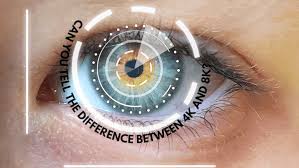Ever walked into an electronics store and been bombarded with terms like “4K” and “8K”? These days, TV resolution seems to be the new battleground, with manufacturers boasting ever-increasing numbers. But can our eyes actually tell the difference? Let’s unpack the world of 8K resolution and see if it’s worth the hype.
Why Choose 8K?
Imagine watching a movie and feeling like you’re transported right into the scene. That’s the promise of 8K resolution. With a whopping 7680 x 4320 pixels, 8K boasts four times the detail of 4K and a staggering 16 times the resolution of Full HD! This translates to sharper, crisper images with finer details. Think individual blades of grass on a vast field or the intricate patterns in a spider web – all rendered with stunning clarity.
Types of 8K Resolutions
There are actually two main types of 8K resolutions:
7680 x 4320 (UHDTV-8K): This is the standard 8K resolution used in TVs and displays.
8K DCI (Digital Cinema Initiatives): This format is specifically designed for professional cinema use and has a slightly wider aspect ratio for an even more immersive viewing experience.
Benefits of 8K – Beyond the Pixel Count
While the sheer number of pixels is impressive, 8K offers more than just a sharper picture. Here are some potential benefits:
Enhanced Detail: 8K allows you to see even the minutest details in an image, from the subtle textures of clothing to the intricate patterns on a butterfly’s wing.
Smoother Motion: A display that can handle a 120 fps test is among those that support 8K.This translates to smoother motion, especially beneficial for fast-paced action movies or sports broadcasts. Think action sequences with incredible fluidity, making you feel like you’re right in the middle of the action.
Future proofing: 8K is still a relatively new technology, but as content creators embrace it, you’ll be ready to enjoy the future of high-definition viewing.
Here’s a quick fps test tip: If you’re unsure about the difference in frame rates, watch a high-speed sports clip on different TVs. A higher frame rate (like 120 fps) will display smoother, more lifelike motion compared to a lower frame rate (like 24 fps).
Steps to Experience 8K
Ready to dive into the world of 8K? Here’s what you’ll need:
An 8K TV: The first step is, of course, an 8K TV. These are still on the higher end of the price spectrum, but prices are gradually coming down.
8K Content: Currently, there’s not a ton of 8K content readily available. Streaming services are slowly offering some 8K content, and there are some 8K Blu-ray discs available, but it’s a smaller selection compared to lower resolutions.
HDMI 2.1 Cable: Make sure you have an HDMI 2.1 cable to handle the high bandwidth required for 8K content.
Conclusion
So, can your eyes see 8K? Technically, yes, with good vision you can perceive the increased detail offered by 8K, especially on larger screens and from closer viewing distances. However, the benefit may not be as dramatic as the jump from standard HD to 4K.
The real question is whether the current benefits of 8K outweigh the cost. If you’re a cinephile who wants the absolute best picture quality and are willing to invest in the future, then 8K might be worth it. But for most casual viewers, a high-quality 4K TV might still be the sweet spot, offering excellent picture quality at a more accessible price point.
FAQs
Will I see a big difference between 4K and 8K?
The difference between 4K and 8K can be subtle, especially on smaller screens or from farther viewing distances.
Do I need a massive TV to enjoy 8K?
You’ll likely appreciate the detail of 8K more on larger screens (around 75 inches or more) where you can sit closer and perceive the finer details.





